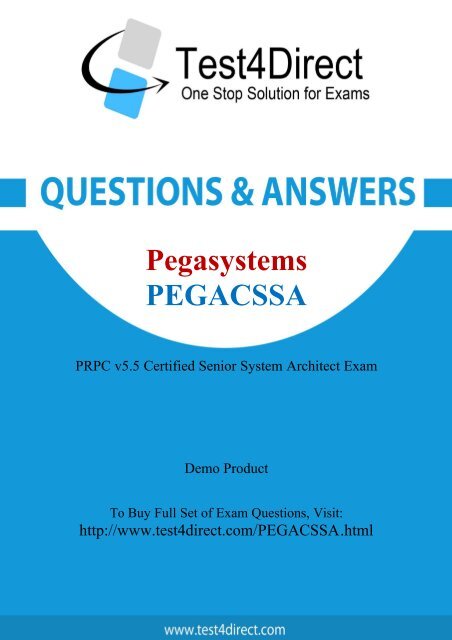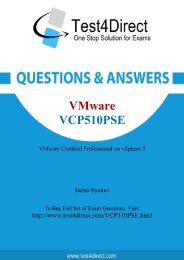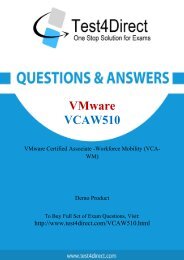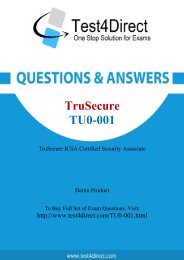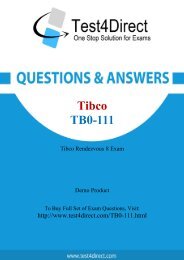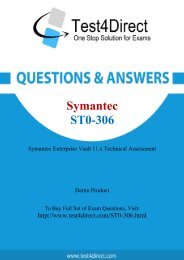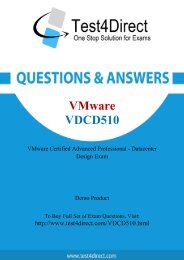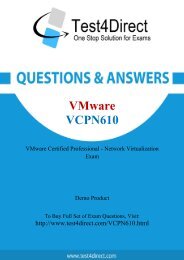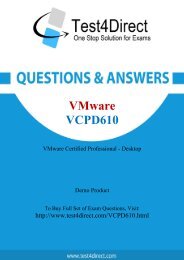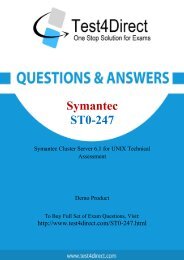PEGACSSA Exam BrainDumps
Test4Direct provides latest PDF questions of Pegasystems PEGACSSA exam. You have an opportunity to pass the Pegasystems PEGACSSA exam in one go. Test4Direct is most accurate source to prepare Pegasystems PEGACSSA exam as your success will become site’s responsibility after purchasing PEGACSSA exam product. There are also lots of discounts and promotion offers that you can avail. Let’s try a free demo http://www.test4direct.com/PEGACSSA.html
Test4Direct provides latest PDF questions of Pegasystems PEGACSSA exam. You have an opportunity to pass the Pegasystems PEGACSSA exam in one go. Test4Direct is most accurate source to prepare Pegasystems PEGACSSA exam as your success will become site’s responsibility after purchasing PEGACSSA exam product. There are also lots of discounts and promotion offers that you can avail. Let’s try a free demo http://www.test4direct.com/PEGACSSA.html
Create successful ePaper yourself
Turn your PDF publications into a flip-book with our unique Google optimized e-Paper software.
Pegasystems<br />
<strong>PEGACSSA</strong><br />
PRPC v5.5 Certified Senior System Architect <strong>Exam</strong><br />
Demo Product<br />
To Buy Full Set of <strong>Exam</strong> Questions, Visit:<br />
http://www.test4direct.com/<strong>PEGACSSA</strong>.html
Question: 1<br />
Which of the following are virtual memory based caches? (Choose Three)<br />
A. Rule Cache<br />
B. Rules Assembly Cache<br />
C. Rule Resolution Cache<br />
D. Lookup List Cache<br />
E. Static Content Cache<br />
F. Dictionary Cache<br />
Answer: A, B, C<br />
Question: 2<br />
When a rule executes what is really executed? (Choose One)<br />
A. XML which is stored in the BLOB<br />
B. Java code which is compiled from the XML stored in the BLOB<br />
C. A class file which is stored in the BLOB<br />
D. A serialized java object which is stored in the BLOB<br />
Answer: B<br />
Question: 3<br />
Which statement best describes the Rules Assembly Cache? (Choose One)<br />
A. The Rules Assembly Cache is a disk based cache that stores the generated XML and resulting class<br />
files, post compilation since what finally gets executed is XML, not java code<br />
B. The Rules Assembly Cache is a memory based cache that reduces PegaRULES database traffic as it<br />
contains copies of rules recently accessed or recently updated by developers<br />
C. The Rules Assembly Cache is a memory based cache that allows Process Commander to rapidly<br />
identify compiled Java CLASS files that correspond to compiled and assembled rules<br />
D. The Rules Assembly Cache is a memory based cache used by PRPC to feed the Instance Cache as<br />
the Instance Cache is the instance of a given rule for which code has been generated<br />
Question: 4<br />
Where can you view the contents of the Rule Instance Cache? (Choose One)<br />
Answer: C<br />
A. Using the SMA you can view the contents of the instance cache which are displayed in the form of<br />
an Excel file<br />
B. Using the Developer Portal you can view the contents of the instance cache which are displayed in
the form of an excel file and is accessed from the tools > instance cache menu<br />
C. By viewing the XML files from the TEMPDIR\PRGenJava\XML directory<br />
D. By viewing the XML files from the pzInsKey column by using JDBC code<br />
Answer: A<br />
Question: 5<br />
What determines which table a work object is persisted to? (Choose One)<br />
A. The Data-Admin-DB-Table record for the class group the work object belongs to and the access<br />
group the current user belongs to<br />
B. The RuleSet the class belongs, and Data-Admin-DB-Table definitions<br />
C. The Data-Admin-DB-Table record associated to the class group the work object belongs to<br />
D. The RuleSet the class belongs to<br />
Question: 6<br />
Question: 7<br />
Question: 8<br />
Answer: C<br />
The BLOB is stored in the pzPVStream column of a table and contains the data associated with the<br />
instance. Which two statements are false? (Choose Two)<br />
A. Since it is a column in a table in a database, you can extract the BLOB and use it in another system<br />
B. The BLOB contains the same clear text xml you see when clicking the rule data or the View XML<br />
option in the clipboard<br />
C. The “PzPVStream” can be eliminated by use of simple tables (those without embedded pages and<br />
page lists)<br />
D. The BLOB enables a single table to store complex data structures that would normally require<br />
multiple tables in a normalized database<br />
Answer: A, B<br />
PegaRULES is installed on a multi-node system, and a copy of the various caches is stored on each<br />
node. Each of these nodes must be updated with rule changes. Which functionality in PRPC manages<br />
the update process? (Choose One)<br />
A. Node-Pulse<br />
B. Rule Cache<br />
C. System-Update<br />
D. System-Pulse<br />
Which statements in regards to commits in PRPC are false? (Choose Two)<br />
Answer: D
A. All database updates require that the requestor holds a lock on the object<br />
B. The system performs commits automatically when processing for a submit operation of a flow<br />
action completes, for both connector and local flow actions<br />
C. Commit operations can trigger the execution of Declare-Trigger rules<br />
D. Assuming distributed transaction is not configured and the deferred operation list contains<br />
operations for only one database. When the system commits all deferred operations for the<br />
requestor, if any of the writes fail, they all fail<br />
E. The deferred operations will be committed when you use the write-now option with the obj-save<br />
method because this causes a commit to occur<br />
Question: 9<br />
Question: 10<br />
Answer: A, E<br />
PRPC can be installed using a WAR or EAR configuration. Which of the following does NOT require an<br />
EAR configuration? (Choose One)<br />
A. JMS message services support need to be provided<br />
B. Support for two-phase commits is required<br />
C. Support for EJB services need to be provided<br />
D. J2EE security is required<br />
E. JSR-94 support is required<br />
Select the valid modes an Agent can have since PRPC 5.4? (Choose Three)<br />
A. Normal<br />
B. Legacy<br />
C. Standard<br />
D. Advanced<br />
E. Modes are not required to be selected for Agents in PRPC 5.4<br />
Question: 11<br />
Answer: E<br />
Answer: B, C, D<br />
Why does PRPC create a Data-Agent-Queue instance when you create a Rule-Agent-Queue instance?<br />
(Choose One)<br />
A. Data-Agent-Queue instances are not locked so they allow you to control the behavior of Agents in<br />
a locked RuleSet at runtime<br />
B. Data-Agent-Queue instances are created by PRPC to support the new Queue For Agent<br />
functionality which was provided since PRPC v5.4<br />
C. Data-Agent-Queue instances are created automatically by PRPC whenever the Queue-For-Agent<br />
method is used in an activity step to queue work for the Agent
D. Data-Agent-Queue instances are data instances which are used by the Queue Manager<br />
functionality to allow for concurrent access to a queued piece of work by agents running on multiple<br />
nodes<br />
E. Data-Agent-Queue instances represent the master definition of PRPC agents and have been<br />
deprecated as of PRPC v5.4 in favor of using Rule-Agent-Queue<br />
Question: 12<br />
Which statement is true regarding how locking works with covers? (Choose One)<br />
Question: 13<br />
Question: 14<br />
Answer: A<br />
A. By default, the cover does not get locked when you open a covered object, but this is configurable<br />
B. By default, the cover is locked when you open a covered object, but this is configurable<br />
C. The cover must always be locked when working on the cover or one of its covered work objects<br />
because updates occur on the cover throughout processing of the covered work objects<br />
D. Cover object locking is identical to that of other work objects, in that it is only locked when it is<br />
opened by a requestor<br />
What purpose and effect does the Obj-Refresh-and-Lock method have? (Choose One)<br />
Answer: B<br />
A. It has no effect if a lock is held and has not expired<br />
B. It will reacquire a lock and will always refresh the contents of the object from the Database<br />
C. If the lock is not held, the method will acquire a lock and always replace the step page contents<br />
with the current values from the database<br />
D. This method has been deprecated as of PRPC 5.3 in support of the Obj-Browse method which<br />
handles refresh and locking automatically<br />
E. This method is highly efficient and will only refresh the object if the content on the clipboard is<br />
older than the current state in the database and will also force lock the object regardless of holds the<br />
lock<br />
What does the rollback method do? (Choose Two)<br />
Answer: A<br />
A. Cancels/Withdraws any pending obj-save and obj-delete methods<br />
B. Rollback is not supported by PRPC when using a WAR deployment. The only way you can do a<br />
rollback is by using the compensating actions method<br />
C. Rollback is a way to rollback an object to a previous state using the History instance for a work<br />
object<br />
D. Rolls back the deferred stack of operations for the specified page<br />
Answer: A, D
Question: 15<br />
What does the system pulse do? (Choose Three)<br />
A. It is used by PRPC to synchronize changes to the Data-Agent-Schedule instances whenever a Rule-<br />
Agent-Queue instance is modified<br />
B. It invalidates rule caches on a per node basis using entries in the pr_sys_updatescache table<br />
C. It processes changes to the Lucene indexes that support full text searches<br />
D. It synchronizes the lookup list cache deletions and any rule-file-deletes<br />
E. It is used by PRPC to send out information to PAL on a weekly basis so that performance analysis<br />
can be performed over a period of time<br />
Answer: B, C, D
THANKS FOR TRYING THE DEMO OF OUR PRODUCT<br />
Visit Our Site to Purchase the Full Set of Actual <strong>PEGACSSA</strong> <strong>Exam</strong> Questions With Answers.<br />
http://www.test4direct.com/<strong>PEGACSSA</strong>.html<br />
We Also Provide Practice <strong>Exam</strong> Software That Simulates Real <strong>Exam</strong> Environment And Has<br />
Many Self-Assessment Features. Download Free Product Demo From:<br />
http://www.test4direct.com/<strong>PEGACSSA</strong>.html<br />
Money Back Guarantee<br />
Check Out Our Customer Testimonials


